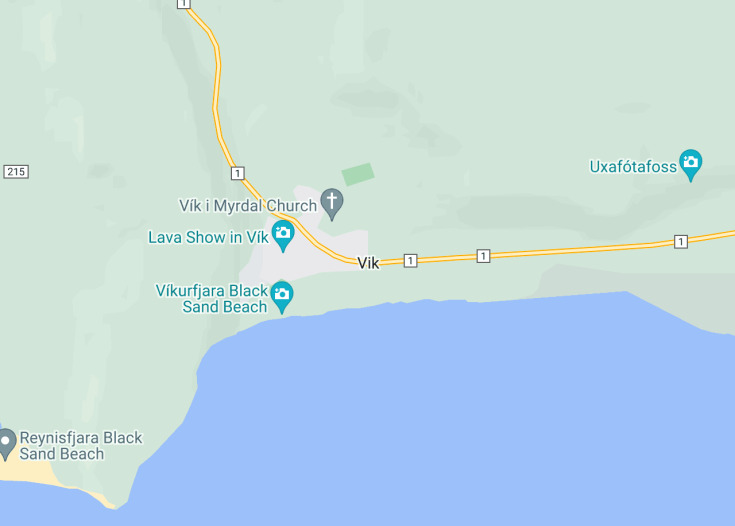Vík í Mýrdal, commonly known as Vík, is a charming coastal town in southern Iceland, renowned for its dramatic landscapes and black sandy beaches. This remote locale is not only picturesque but also serves as a crucial hub for exploring nearby natural wonders such as the Dyrhólaey cliffs and the Mýrdalsjökull glacier. Vík’s unique position by the sea underlines a rare, haunting beauty, where folklore and stark nature intermingle, offering visitors an experience that is both mystic and wild.
When visiting Vík, ensure to dress in layers and bring waterproof gear to enjoy the outdoor activities comfortably, regardless of the unpredictable Icelandic weather.
Travelers to Vík should not miss the sunset at Reynisfjara Beach, where the sun’s setting rays dramatically illuminate the basalt sea stacks and fierce waves, offering a breathtaking vista.
Top things to do & see in Vik
Select the following sights and activities to discover best tickets and tours available in Vik.
Vik: The Hidden Treasure of Iceland
| Country | Iceland |
| Time in Vik | GMT-0 |
| Language spoken | Icelandic |
| Population | 318 people (Statistics Iceland, 2023) |
| Currency | Icelandic Króna (ISK ₽) |
| Airports |
|
Vik, a quaint town nestled in the southern part of Iceland, stands as a quiet sentinel over the vast Atlantic. Known for its stunning landscapes and iconic black sand beaches, Vik is the most southern village in Iceland and offers an array of mesmerizing natural sights, including the famous Reynisfjara shore. Despite its small size, it serves as an essential community for the region, providing amenities and acting as a commercial center for local farmers and businesses.
Where is Vik?
Vik is located at the southernmost tip of Iceland, set against a backdrop of steep cliffs and the vast ocean. It is a cornerstone for sightseeing on Iceland’s south coast.
Distances:
| Route | Distance by car | Time by car |
|---|---|---|
| Reykjavík to Vik | 112 miles (180 km) | Approximately 2.5 hours |
| Keflavík to Vik | 146 miles (235 km) | Approximately 3 hours |
What is Vik famous for?
Vik is renowned for its dramatic ocean views, the unique Reynisfjara black sand beach, and its close proximity to natural wonders such as the Dyrhólaey and Katla geoparks. It serves as a crucial hub for exploring the natural beauty of Iceland’s south coast.
History
Settlement Era (874 – 930 AD)
The history of Vik, a charming village in Iceland, stretches back to the time of the Norse settlement in the late 9th century. The area was first inhabited by Norse settlers, drawn to its fertile lands and abundant resources. The dramatic landscapes provided an ideal backdrop for the resilient communities that began to take root here.
Medieval Period (930 – 1500 AD)
Throughout the medieval period, Vik served primarily as a vital trading post between Norse communities. The rich marine life and favorable sailing conditions made it a strategic location for trade and fishing. Despite its advantageous position, the village remained small, governed by the chieftains and closely tied to the spiritual and cultural practices of the Medieval Norse.
Early Modern Period (1500 – 1800 AD)
During the early modern period, Vik’s population grew modestly. The introduction of Christianity brought new architectural styles and societal changes, overlaying the pagan beliefs and traditions. The village’s identity began to solidify, marked by the rough stone church that emerged as a community focal point.
19th Century – Early 20th Century (1800-1950)
By the 19th century, Vik began to modernize, influenced by broader European industrial and cultural shifts. A pivotal point was the establishment of Iceland’s sovereignty, and Vik contributed fishing, wool, and other goods to the national economy, building its local infrastructure. However, the harsh weather and occasional volcanic eruptions challenged the resilience of its people.
Modern Day (1950 – Present)
In recent decades, Vik has transformed from a secluded fishing village into a remarkable tourist destination. The local economy is now significantly supported by tourism, with visitors drawn to its dramatic coastline, distinctive black sand beaches, and iconic natural landmarks like the Reynisdrangar sea stacks.
Visit Vik
What to see and do in Vik
Explore the enchanting village of Vik, set against the backdrop of steep cliffs and the vast Atlantic Ocean. Noteworthy attractions include:
- Reynisfjara Beach: Known for its stunning black sand and powerful waves, this beach is a must-visit for its dramatic beauty and unique geological formations.
- Reynisdrangar Sea Stacks: These towering basalt sea stacks legend says were once trolls caught by the dawn.
- The Church of Vik: Perched on a hill, this iconic church offers panoramic views of the surrounding landscape and is a beacon for the community.
- Dyrhólaey Peninsula: Offering breathtaking views and rich birdlife, including puffins during nesting season.
Annual Events in Vik
Vik is lively with events throughout the year, prominently featuring the Vikurfestival in July, celebrating local culture with Icelandic music, dance, and culinary delights.
Best time to visit Vik
The prime time to visit Vik is during the summer months of June to August, when the weather is most favorable and the days are longest, allowing for extensive exploration of the natural scenery.
Is Vik worth visiting?
Indeed, Vik is well worth visiting. With its unique natural landscapes, rich history, and vibrant cultural scene, it offers a distinctive Icelandic experience. The dramatic black sand beaches, fascinating wildlife, and the warmth of the local community make Vik an unforgettable destination for travelers seeking both adventure and tranquility.








